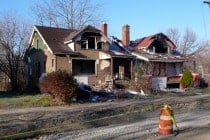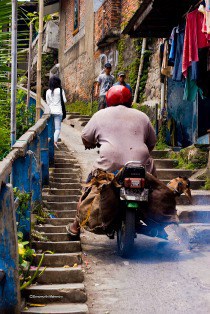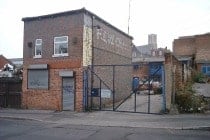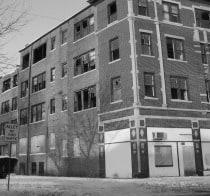To survive in the urban environment you will need to learn and use and whole new set of skills and tools than you might ordinarily consider in other survival situations. Urban survival techniques and objectives are completely different from the survival skills you would use in the wilderness.
By Dan C. – a contributing author of SurvivalCache.com
The Urban Reality
Most TV shows focus on wilderness survival. These shows range from participants with plenty of supplies task to reach an extraction  point in a defined time period, to those naked with only one survival tool on a mission to survive a predetermined amount of time. In most cases these competitions clearly illustrate the outstanding skills, pit falls and difficulties of the participants in their respective survival environments. I must admit, most do an exceptional job of surviving their ordeal.
point in a defined time period, to those naked with only one survival tool on a mission to survive a predetermined amount of time. In most cases these competitions clearly illustrate the outstanding skills, pit falls and difficulties of the participants in their respective survival environments. I must admit, most do an exceptional job of surviving their ordeal.
In reality, these shows represent an aspect of survival that most of you will never encounter. Thus, as much as you may learn from watching these programs, the skills seen on the show will be of very little value in your most common environment, an urban setting. Wilderness survival skills such a primitive fire starting, hunting, building a shelter, and water purification techniques are all valuable skills to know but are virtually useless in the urban survival environment.
Situational awareness, personal protection, planning and preparation are far more important aspects of preventing and surviving an untoward urban event. Urban survival know-how is divided into two very different scenarios of the urban environment. One is the individual, small scale or personal adverse event, such as robbery, mugging, carjacking, or home invasion. The other, is the large scale urban survival event such as natural disasters, civil unrest and economic collapse.
The likelihood you could find yourself in any one of these urban survival situations is very real and, in most cases, it will happen to each of you more than once in your lifetime. Thus, it is essential to be prepared to prevent yourself from being a victim of circumstance.
Urban survival is dependent upon the application and use of six distinctive principals: Planning, Preparation, Training, Protection, Communication and Safe Haven. Due to the space allocated, I cannot cover each of these topics in great detail, so I will strive to provide you the foundation of each principal. With this knowledge, you can prepare yourself for any untoward event that may occur in the urban environment.
Planning
Planning is essential to the success of any project. Without a plan you have no direction, no defined objectives and no documentation of  your progress. Setting goals and objectives is imperative. It is the key to a successful outcome. In this case, the goal is to be supplied, trained, and prepared for any form of urban survival situations. Your urban survival plan should consist of the following key elements Preparation, Training, Security, Protection, and Safe Haven. Within each of the major sections there are vital objectives that need to be accomplished to improve success of survival. There are two general sets of plans you will need to develop to meet your individual and unique circumstances. First is the plan to set in place all the tools you will need to prepare for your ability to survival urban emergency.
your progress. Setting goals and objectives is imperative. It is the key to a successful outcome. In this case, the goal is to be supplied, trained, and prepared for any form of urban survival situations. Your urban survival plan should consist of the following key elements Preparation, Training, Security, Protection, and Safe Haven. Within each of the major sections there are vital objectives that need to be accomplished to improve success of survival. There are two general sets of plans you will need to develop to meet your individual and unique circumstances. First is the plan to set in place all the tools you will need to prepare for your ability to survival urban emergency.
The second step of planning is a group of smaller plans that are developed to assure that everyone in your family is educated on the procedures to follow during an untoward event. You should have at a minimum four operational plans: a natural disaster plan, a get out of town plan, a fire plan and a home invasion/robbery plan. Each of these plans has distinct elements that make them independent of each other. However they all involved one common important element… everyone is on the same page. This means everyone will have a much better chance of surviving any one of these unexpected events.
Preparation
Preparation is the key to success in all aspects of your life. In a survival situation, it could mean the difference between living and dying. This is one of the hardest aspects of getting ready for an urban survival event. We are so accustom to having everything from food, water, electricity, transportation, security and many more things right at our finger tips. It is so easy to put off getting prepared. However, in an urban survival event, many of these essential items may not be available for extended periods of time. It is so easy to say it will not happen here or to us. The truth is disasters can strike anytime, anywhere, unannounced. So being prepared is key. Trying to prepare in the last minute, is a receipt for failure. So having enough food on hand, propane to cook and heat if there is no electricity; water stored in tubs or rain barrels, personal protection tools and personal protection resources such as ammo, stored fuel for emergency evacuations or back-up generators. All are critical.
Training and Practice
There are several areas of training that you should seriously consider as part of your urban survival plan. The training programs I highly  recommend are courses on situational awareness, personal protection techniques such as martial arts and firearms training, obtaining a license to carry a weapon, first aid, and physical fitness. Training in each of these areas adds depth to your preparedness and ability to manage numerous aspects of situations that may occur during an urban survival event. I cannot stress how important training is to your ability to survive.
recommend are courses on situational awareness, personal protection techniques such as martial arts and firearms training, obtaining a license to carry a weapon, first aid, and physical fitness. Training in each of these areas adds depth to your preparedness and ability to manage numerous aspects of situations that may occur during an urban survival event. I cannot stress how important training is to your ability to survive.
Equally important, is practice. Once you have received training in any of the areas mentioned above, you must practice the skills to remain competent. Conducting drills is essential to making sure everyone is familiar with the established plans. You need have practice drills of your in home plans, such as your fire, home invasion, and get home plans. I cannot emphasize how important practice is; it is the true key to competency and can save your life.
Protection
Protection is one of the key elements of surviving an adverse urban survival event, whether it is a large scale disaster or an isolated, personal event. There are three distinctive areas where protection is essential you, your family, followed by your home or dwelling and then your travel needs. It is easy to forget, but you must protect yourself first. If you are injured or killed, then you lose the ability to protect your family. Robberies, carjackings, home invasions all occur when you least expect it. That is how they are planned. The bad guys in these scenarios’ are looking for people that are not paying attention, distracted, and unprepared making them easy targets. So maintaining a strong sense of situational awareness and being prepared to protect yourself is critical to prevention and survival. The vast majority of natural disaster related urban survival events is followed immediately by chaos, then in many cases by civil unrest such as looting. During the first two stages of an unexpected horrific urban event it is exceedingly important that you morph into your protection mode of operation.
In the latter situation, you will need to immediately increase your situational awareness skills, be prepared to use your first aid training  and anticipate and be prepared to use your personal protection skills to survive. In both the small and large scale urban environment scenarios mentioned above, it is essential you have ready access to your personal protection tools. No matter where you are you must be able to access them and be ready to use if needed.
and anticipate and be prepared to use your personal protection skills to survive. In both the small and large scale urban environment scenarios mentioned above, it is essential you have ready access to your personal protection tools. No matter where you are you must be able to access them and be ready to use if needed.
If the event means you must move to a new location then you must prepared to protect yourself while making the transition. This is one area many people forget about. In many cases, when and untoward event occurs you may need to move to a new location. During this transition to a new location you want to make sure you can protect yourself.
Communication
Knowing where everyone is and that they are safe is always one of the first concerns of family members. How many times have you heard in news reports that people within a disaster zone or home fire are trying to determine where the other members of family are located. It is very common. Today we are very fortunately we have cell phones. Mobile devices that enable us to communicate from almost where ever we may be. It is evident cell phones play a vital role in helping you communicate and improve our ability to find others and seek help.
Safe Haven
Your safe haven is kind of like your exit on an airplane, the closest one may be behind you. A safe haven is any location that provides a  safe place for you and your family. There are two main safe havens. The first is a room within a facility or your home that is set up to function as a safe place for anyone to go in when there is a need to protect yourself from any threat. The second is any location you have access to that will enable you to gain protection from the outside world. A safe room can be as extensive as a room with steel reinforced walls and door that contains a large supply of water and food, multiple personal protection tools and several communication devices or it could be as simple as a closet. In general, the safe haven in your house should at a minimum consist of the following elements. A room with a solid core door, enhanced hinges, a locking door knob, a personal protection tool, a communications device, water, flashlight and a small supply of snacks.
safe place for you and your family. There are two main safe havens. The first is a room within a facility or your home that is set up to function as a safe place for anyone to go in when there is a need to protect yourself from any threat. The second is any location you have access to that will enable you to gain protection from the outside world. A safe room can be as extensive as a room with steel reinforced walls and door that contains a large supply of water and food, multiple personal protection tools and several communication devices or it could be as simple as a closet. In general, the safe haven in your house should at a minimum consist of the following elements. A room with a solid core door, enhanced hinges, a locking door knob, a personal protection tool, a communications device, water, flashlight and a small supply of snacks.
The first is located in your house. You may have more than one safe room in your house depending on its layout. For example, if you live in the three story house, you may wish to have a safe room on each floor, at least one on the top and bottom floors. Naturally, family and friends can be located throughout the house. Should an event such as a home invasion take place then you want the people on the top and bottom floors to be able to seek a safe haven in those areas without having to transverse the main floor.
A safe haven can be your office, grandma’s house, your sister’s house, or a friend’s house. Should a large scale event happen such as a severe thunderstorm, ice storm, snow storm, tornado or flood you may not be able to get to your home. So the nearest safe haven may be one of these locations. Thus, as part of your preparation and planning you should have keys to all these locations on your key chain. In addition, this should be part of your natural disaster plan, so that your family will know where you will most likely be if any one of these types of events should occur.
Summary
In summary, urban survival is considerably different than wilderness survival and requires another whole set of skills and understanding. You will need to think differently and act accordingly. Because the obstacles and challenges will be totally different than if you are in the wilderness. However, the fundamental result is the same, survive. Start the process of preparing, training and practicing now. Don’t put it off. It will be necessary for your survival in the urban environment.
About Dan C: Dan has lectured in over 250 American Heart Association Advanced Cardiac Life Support Provider Courses (ACLS) and over 40 ACLS Instructor Courses, over 50 American College of Emergency Physician Basic Trauma Life Support Provider (BTLS) Courses and 20 BTLS Instructor courses and in over 30 American College of Surgeons Advanced Trauma Life Support Provider (ATLS) Courses, 5 ATLS Instructor courses, 40 American Heart Association Pediatric Advanced Life Support (PALS) Provider and Instructor Courses and 30 American College of Emergency Physicians Advanced Pediatric Life Support (APALS) Provider and Instructor Courses. He has also lectured nationally at several national medical meetings on Trauma verses Medical Patient Assessment, Emergency Airway Management, Pediatric Resuscitation, Emergency Trauma Patient Assessment and Management, Emergency Cardiac Care, and Critical Care Aeromedical Transport.
by Dan C.







